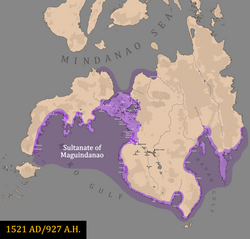
Back سلطنة ماغويندناو Arabic ماقويندناو سولطانلیغی AZB Sultanato nin Maguindanao BCL Sultanat von Maguindanao German Sultanato de Maguindánao Spanish Sultanat de Maguindanao French Kesultanan Maguindanao ID Sultanato di Maguindanao Italian マギンダナオ王国 Japanese 마긴다나오 술탄국 Korean
Sultanate of Maguindanao Kasultanan nu Magindanaw كسولتانن نو مڬیندنو | |||||||||||
|---|---|---|---|---|---|---|---|---|---|---|---|
| 1515[1][2]–1899[3] or 1926[4] | |||||||||||
|
Flag | |||||||||||
 Territory of the Sultanate of Maguindanao in 1521 (purple) and its subjects (light purple) according to various accounts. | |||||||||||
| Capital | |||||||||||
| Common languages | |||||||||||
| Religion | Islam | ||||||||||
| Demonym(s) | Magindanawn | ||||||||||
| Government | Absolute monarchy | ||||||||||
| Sultan | |||||||||||
• 1515–1543 | Sharif Kabungsuwan | ||||||||||
• 1597–1619 | Kapitan Laut Buisan | ||||||||||
• 1619–1671 | Sultan Dipatuan Qudarat I | ||||||||||
• 1896–1926 | Sultan Mangigin | ||||||||||
• 1899 | Datu Piang (Cotabato and Tamontaka) | ||||||||||
| History | |||||||||||
• Established by Sharif Kabungsuwan | 1515[1][2] | ||||||||||
• American occupation of Cotabato | December 1899 | ||||||||||
• Death of Sultan Mangigin | 1926 | ||||||||||
• Disestablished | 1899[3] or 1926[4] | ||||||||||
| Currency | Barter | ||||||||||
| |||||||||||
| Today part of | Philippines | ||||||||||
| History of the Philippines |
|---|
 |
| Timeline |
|
|
| Part of a series on the |
| Pre-colonial history of the Philippines |
|---|
 |
| See also: History of the Philippines |
The Sultanate of Maguindanao (Maguindanaon: Kasultanan nu Magindanaw, Jawi: كسولتانن نو مڬیندنو; Filipino: Kasultanan ng Mangindánaw) was a Sunni Muslim sultanate that ruled parts of the island of Mindanao, in the southern Philippines, especially in modern-day Maguindanao provinces (Maguindanao del Sur and Maguindanao del Norte), Soccsksargen, Zamboanga Peninsula and Davao Region.
Its known historical influence stretches from the peninsula of Zamboanga to bay of Sarangani until Davao Gulf. During the era of European colonization, the sultanate maintained friendly relations with British and Dutch traders.[5]
- ^ Kalipa, Candidato L.; Lumapenet, Husna T. (December 2021). "The Authorities and Customary Practices of the Buayan Sultanates in the Philippines" (PDF).
- ^ Bacani, Benedicto R. (January 2005). "The Mindanao Peace Talks: Another Opportunity to Resolve the Moro Conflict in the Philippines" (PDF).
- ^ Rodríguez, Rufus B. "Mindanao's Participation in the Philippine Revolution".
{{cite journal}}: Cite journal requires|journal=(help) - ^ Donoso, Isaac (March 2, 2023). Bichara: Moro Chanceries and Jawi Legacy in the Philippines. Springer. ISBN 978-9811908200.
- ^ Palafox, Queenie. "The Sultan of the River". National Historical Commission. Archived from the original on June 17, 2013. Retrieved March 16, 2013.
